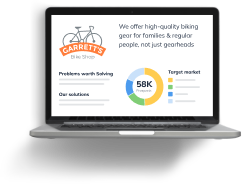What is a pitch deck?
A pitch deck is a brief presentation, ranging from 10-20 slides, that provides an overview of your business. Also known as a slide deck or start-up deck, it should cover the key points of your business plan, the products and services you provide, high-level financial projections, and funding needs. Your pitch deck should stand on its own as a visual document, but it will primarily be used as a tool to present the story of your business through an elevator pitch.
Why do you need a pitch deck?
A pitch deck is designed to inform people about your business. Typically these are investors or funding organizations that need to understand if your business is viable. In short, you need a pitch deck to pursue funding. However, the primary goal of your deck is not to actually secure that funding.
Instead, your pitch deck should help you secure that next meeting. Every type of funding is not a single-step process. You’ll work through multiple interactions with lenders, investors, and venture capitalists before the talk of a dollar amount emerges.
Remember, your pitch deck and pitch presentation are likely some of the first things that an investor will see to learn more about your company. So, you need to be informative and pique their interest. You want investors to ask to see more after they hear your pitch and not just show you to the door.
So, while a solid pitch deck is critical to raising money, the key goal of the deck is to get to the next step—another meeting and a request for more information. In addition, your deck may become useful in other capacities, including hiring and onboarding. The more information you can succinctly convey about your business, the more useful it will be.
How to get the most out of the pitch gallery
Every pitch deck will be different. Yes, there are best practices and specific content you should cover—which you can read more about below—but the design, formatting, and even the way you present it will be unique to you and your business. That being said, there’s nothing wrong with using an example to kickstart the creation of your own pitch deck.
Choose from a pitch deck template or industry example
With this gallery, you have the option to view specific industry pitches or get inspired by real-world pitch deck examples.
If you’re looking for a pitch deck for a specific industry, we recommend viewing our Pitch Deck Templates. These pitches are split into industry categories, such as eCommerce, restaurant or real estate, with specific copy and data you can reference. They’re also connected directly to our library of Sample Business Plans, which can help you create both your Pitch and your Plan with the same example.
Now, sometimes you just need something to reference that can provide that aha moment. If you’re looking for proven pitch deck examples to help guide the design and copy of your pitch, then check out our Industry Examples. These are the actual pitch decks used by the founders of companies like Airbnb, Uber, and Shopify that helped them acquire funding.
What to include in an investor pitch deck?
Narrowing down what you should include in your pitch deck can be difficult. It’s all too easy to want to dump every bit of relevant information into a deck to make sure you have your bases covered. All this will do, is create an overly lengthy and dense presentation that will fail to convince anyone that they should be interested in your business.
You want your pitch deck to be short and easy to follow, so it’s best to keep your presentation under 20 slides. Within that limit you’ll want to be sure that you cover the following:
Vision and value proposition
A quick one-sentence overview of your business and what you provide to your customers. The goal here is to quickly convey why an investor should care about your business and the rest of your pitch. Just try to keep it short, to the point, and memorable.
Problem
You need to showcase that there is a problem that potential customers have. That this issue is affecting an underserved group of individuals that don’t currently have viable options. You want to take investors on a journey, making the problem as real as possible.
Opportunity
Your opportunity is designed to expand on the problem you’ve uncovered. This is where you define your ideal customer, the market size, and what you can realistically acquire. Start with the total opportunity, and break it down into segments to show that you’ve thought through what is viable for your business.
Solution
Knowing there’s a problem and an opportunity to solve it isn’t good enough without a solution. Here, you’ll describe your product or service and how it effectively addresses the issue you outlined. If you can, provide images or even an MVP of your solution to better illustrate the value and usability, potentially making it more real for those you’re pitching to.
Business model
Your business model will encapsulate everything it takes to make and sell your product or service, as well as how and what the customer will pay. In short, this is a description of how your business will make money. To have a successful and convincing business model, you just need to be sure that you can collect more money than it costs to run your business.
Validation
If you have any tested proof, which can be as simple as customer interviews or as advanced as pre-sale numbers, you’ve validated your idea. This helps prove that your business is viable and eliminates some of the perceived risk for investors. This is where you can also display your current and anticipated milestones to outline what you’ve achieved and that there is a plan in place for growth.
Marketing and sales strategy
You’ve outlined who your customers and attainable market are, and this is where you detail key tactics to get their attention. How will you get your business in front of them? What channels, messaging and resources will be necessary to do so? It’s important that you have a solid grasp of your marketing and sales process, and can highlight how it will be different from the competition.
Team
Highlight the key team members that you do have, their successes, and why their expertise is valuable in their roles. Now, you may only be a team of one, but it’s important to outline the organizational structure of what your business will grow into. Identify the gaps you’ll need to fill, why they’re critical for growth, and even list out potential candidates you have in mind.
Financials
Investors want to see your financial documentation and can expect at least three years of sales, cash, and income statement forecasts. However, for your pitch deck, you should limit your financial presentation to charts and graphs that cover sales, total customers, expenses, and profits. Be realistic here, and be sure you are prepared to discuss your reasoning as well as back up your presentation with a full financial plan.
Competitive analysis
You’ve likely mentioned your competitors when speaking about the opportunity, solution, and sales strategy. Here is where you display your full analysis and layout the full competitive landscape and how you’re different than current competitors. This slide should describe what your key advantages are and how you’ll differentiate your products and services.
Use of funds
The pitch is designed to get that next meeting, but you should address how much money you’re looking for at the start. Additionally, you need to outline how you will use the funds and if possible, connect them to your milestones. It’s likely that things will change over time, but having a plan upfront instills confidence in investors that you will use the money effectively.
Additional slides
Not every pitch deck will be or should be the same. Depending on your business, you may not need to cover everything included in these examples, or you may need to address additional details. For example, you may want to include your exit strategy, proposed partnerships, or even a quick demo of the product to showcase its value. Just be sure anything that you include serves the story of your business and helps frame the value of what you’re doing.
Over time, you may even build up a larger pitch deck that includes expanded documentation within an Appendix. This could include things like full financial statements, an expanded product timeline, organizational chart, or marketing materials. Just be sure that you start with the abbreviated version of your pitch first, and create an expanded version over time as it becomes necessary.
In many ways, this is the same process as building out a Lean Plan before diving into a full business plan. It’s faster, helps get your information down, and leaves room to expand over time. Speaking of which…
Need to write your business plan?
Developing your pitch deck is only the start of your business planning journey. You’ll want to follow up on a successful investor pitch with the necessary planning documentation to support your presentation. After all, the purpose of your pitch deck is to get that next meeting, and having a full business plan prepared ensures you’re ready to take that next step.
Not sure where to start? Check out our library of over 500 sample business plans for inspiration. Or for a modern solution with step-by-step instructions that connect your business plan, pitch, and financials together, you may want to check out LivePlan. It will help you build everything needed for outside investment—taking you from a simple template to a full business plan in as little as 30 minutes.




































